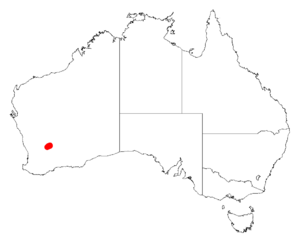Chiddarcooping wattle facts for kids
Quick facts for kids Chiddarcooping wattle |
|
|---|---|
| Conservation status | |
| Scientific classification | |
| Genus: |
Acacia
|
| Species: |
lobulata
|
 |
|
| Occurrence data from AVH | |
The Chiddarcooping wattle (Acacia lobulata) is a unique shrub. It belongs to the Acacia family, also known as wattles. This plant is found only in a small part of southwestern Australia.
It was first recognized as a rare plant in 1997. Today, it is listed as an Endangered plant. This means it is at high risk of disappearing forever. It is protected under Australia's Environment Protection and Biodiversity Conservation Act 1999.
What it Looks Like
This wattle is an upright, open shrub. It usually grows to be about 1 to 2 meters (3 to 6.5 feet) tall. It often has a thin, spreading shape.
Its bark is smooth. The branches are slightly angled and have small bumps. They also feel a bit sticky due to a natural resin.
Like most Acacia species, it does not have true leaves. Instead, it has special flattened stems called phyllodes. These phyllodes are a dull grey-green color. They are not perfectly even and have curved, pointed tips.
The Chiddarcooping wattle blooms in July. It produces bright yellow flowers. These flowers grow in round, ball-shaped clusters. Each cluster is about 3.5 to 4.5 millimeters across. They contain 15 to 17 small yellow flowers.
After flowering, seed pods form. Inside these pods are dull, dark brown seeds. The seeds are oblong, meaning they are longer than they are wide. They measure about 4 to 5.5 millimeters long and 1.8 to 2.3 millimeters wide.
Where it Lives
The Chiddarcooping wattle grows in a small area of Western Australia. This area is in the Wheatbelt and Goldfields-Esperance regions.
It prefers to grow on low, rocky outcrops made of granite. You can find it in gritty loam or sandy soils. Its entire natural home is only about 17 kilometers (10.5 miles) wide.
There are only three known groups of these plants. They live next to the Chiddarcooping Nature Reserve. This area is within the Westonia and Nungarin Shires.
The wattle grows as part of shrubland or open woodland communities. It shares its home with other plants. These include Acacia andrewsii, Daviesia nematophylla, and Eucalyptus yilgarnensis. Other neighbors are Melaleuca uncinata and Austrodanthania setacea.


